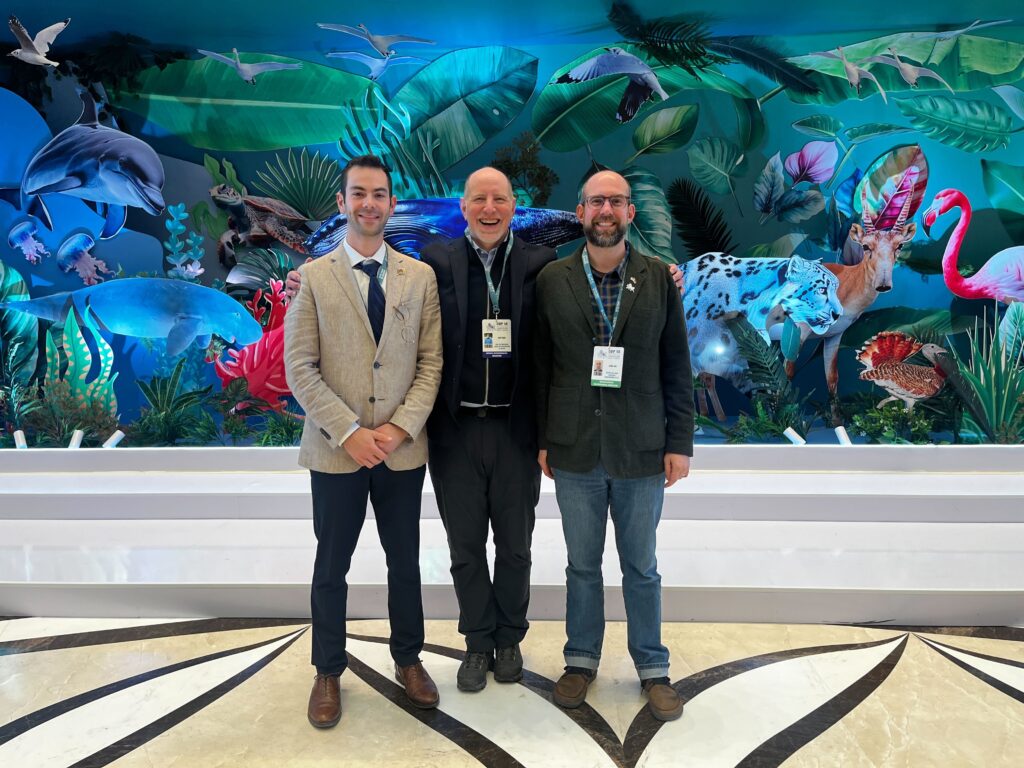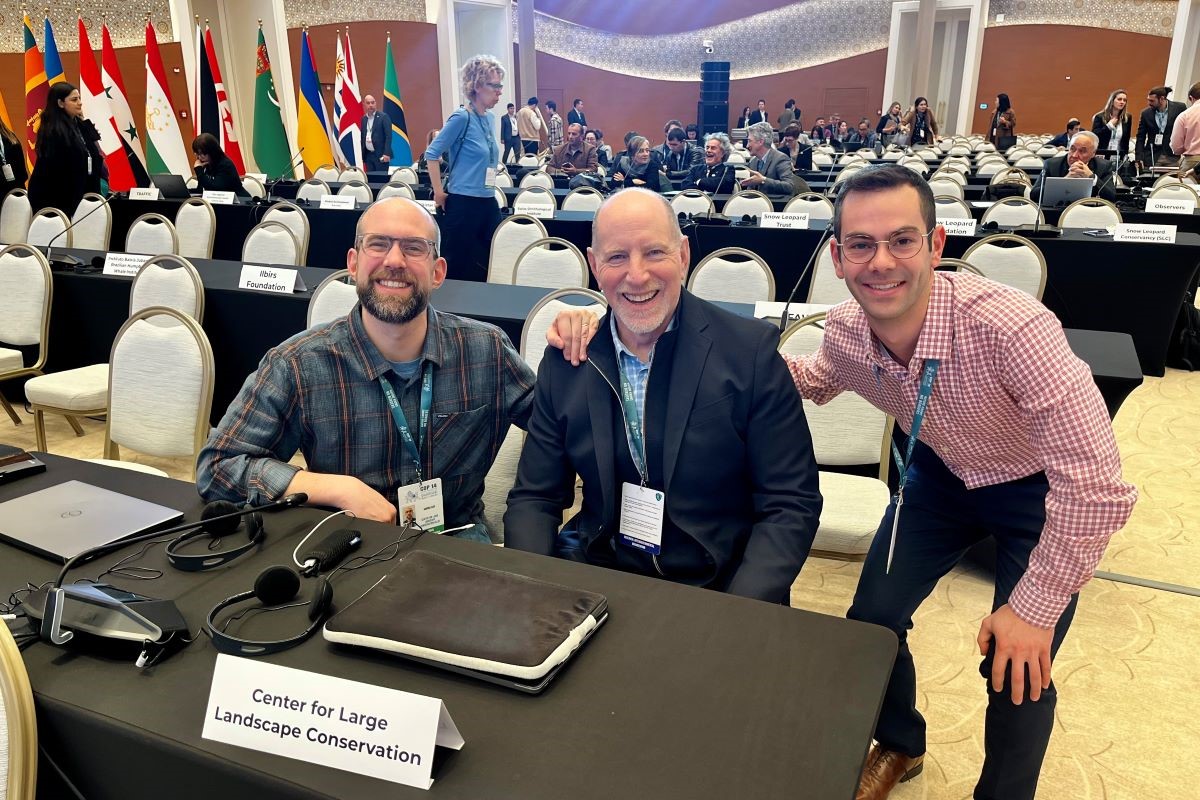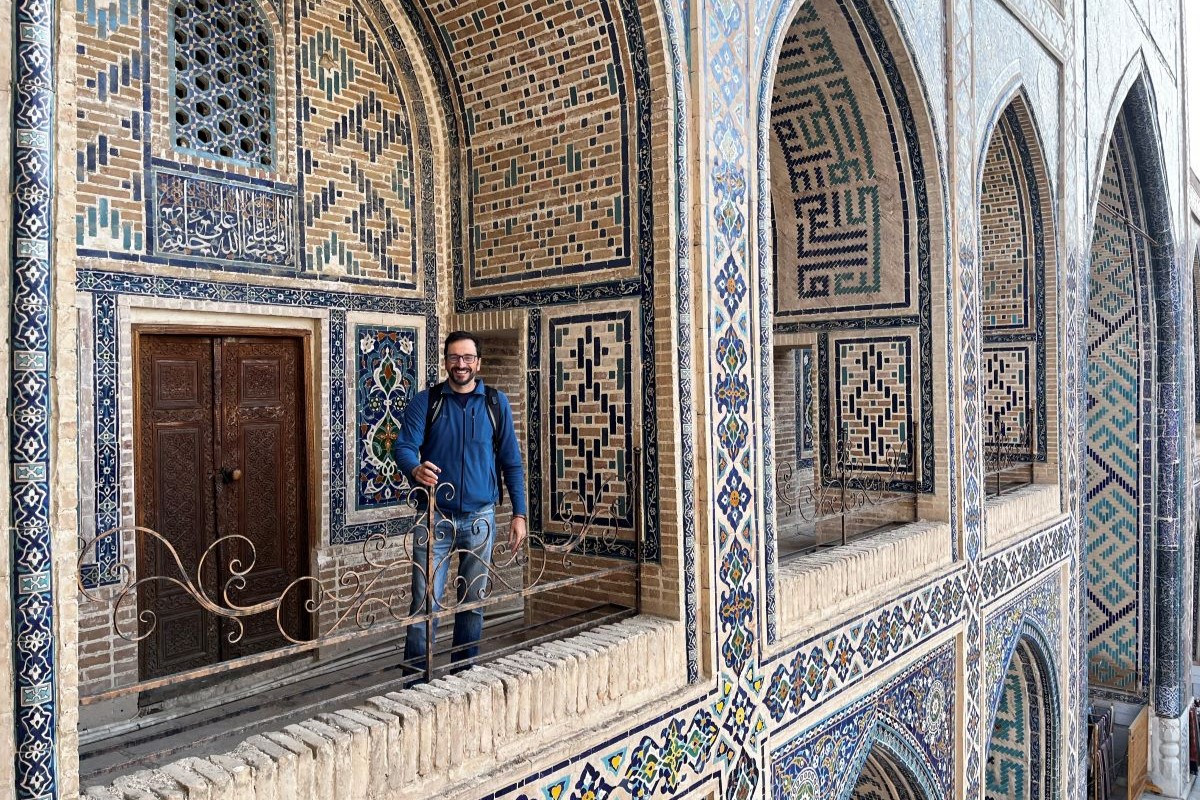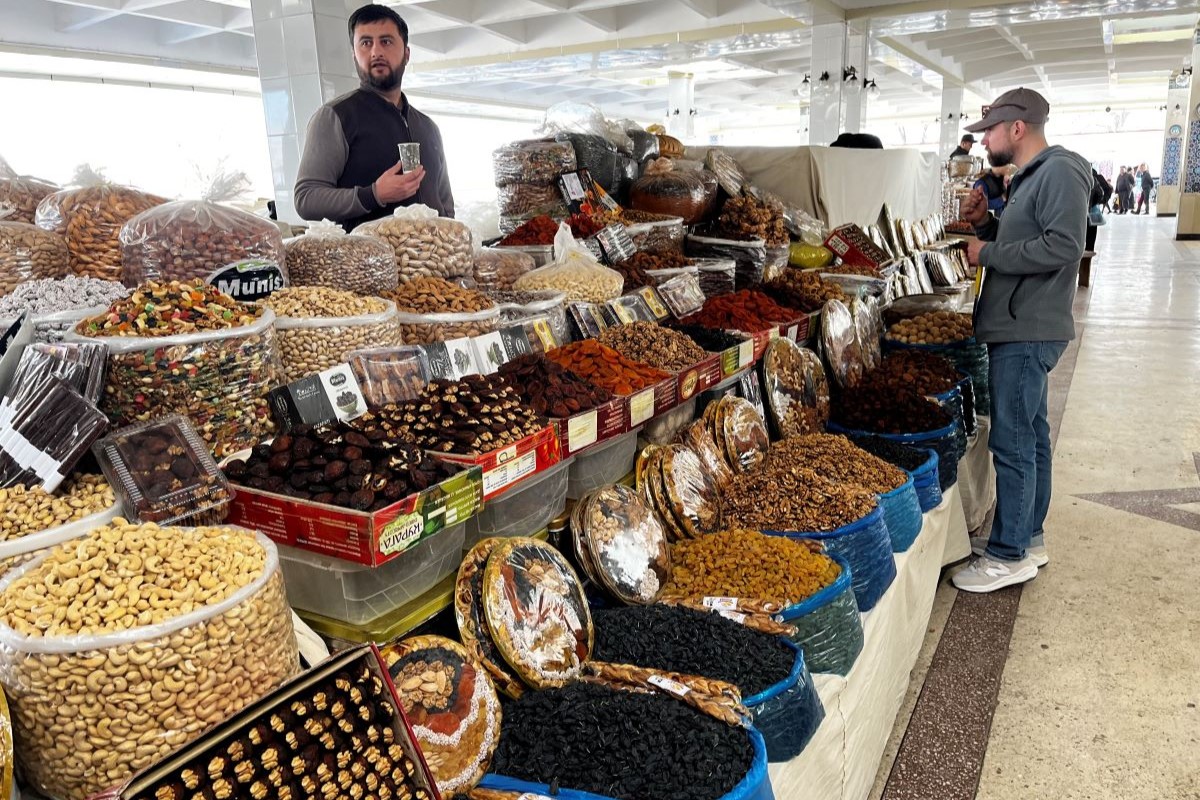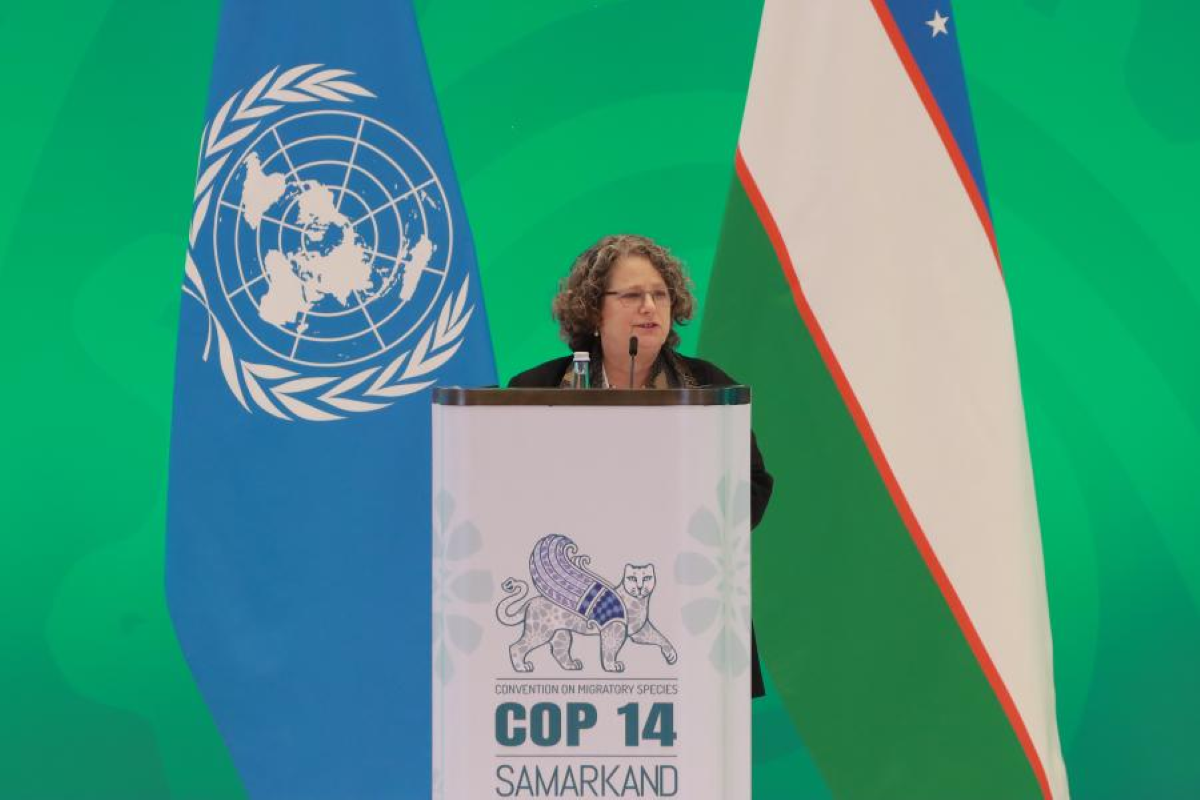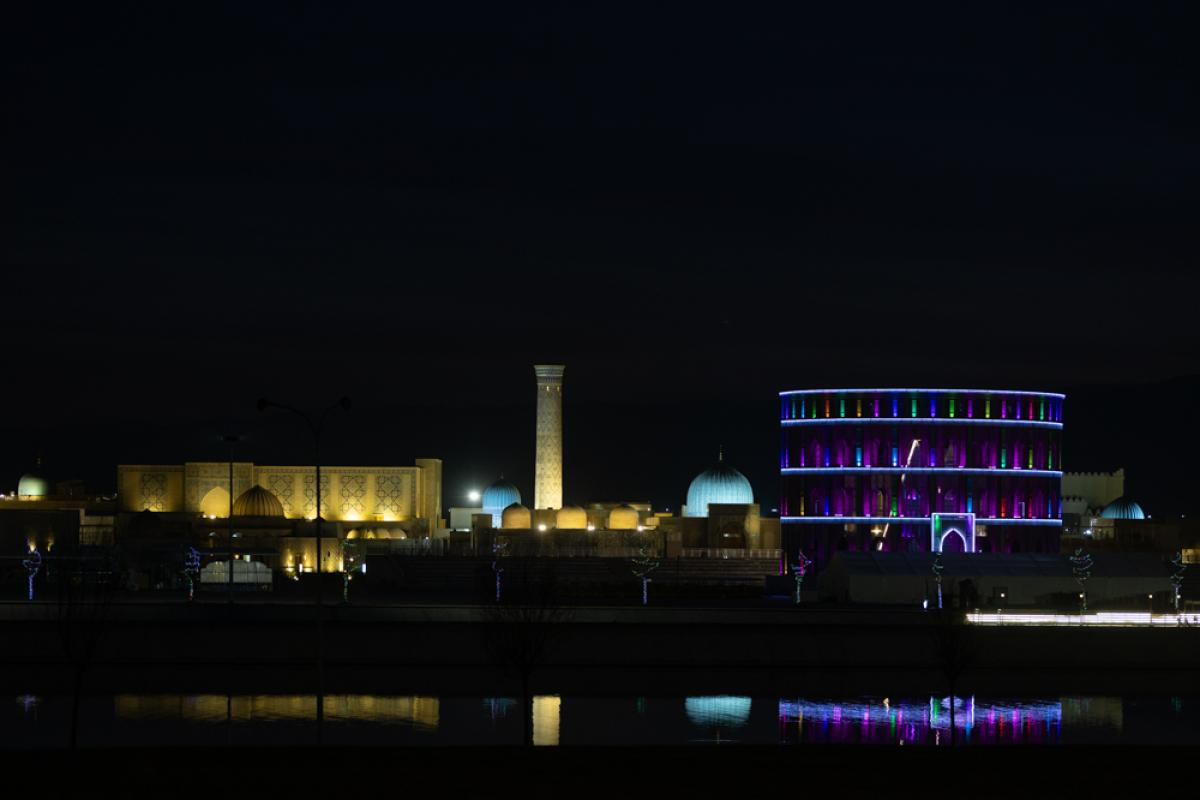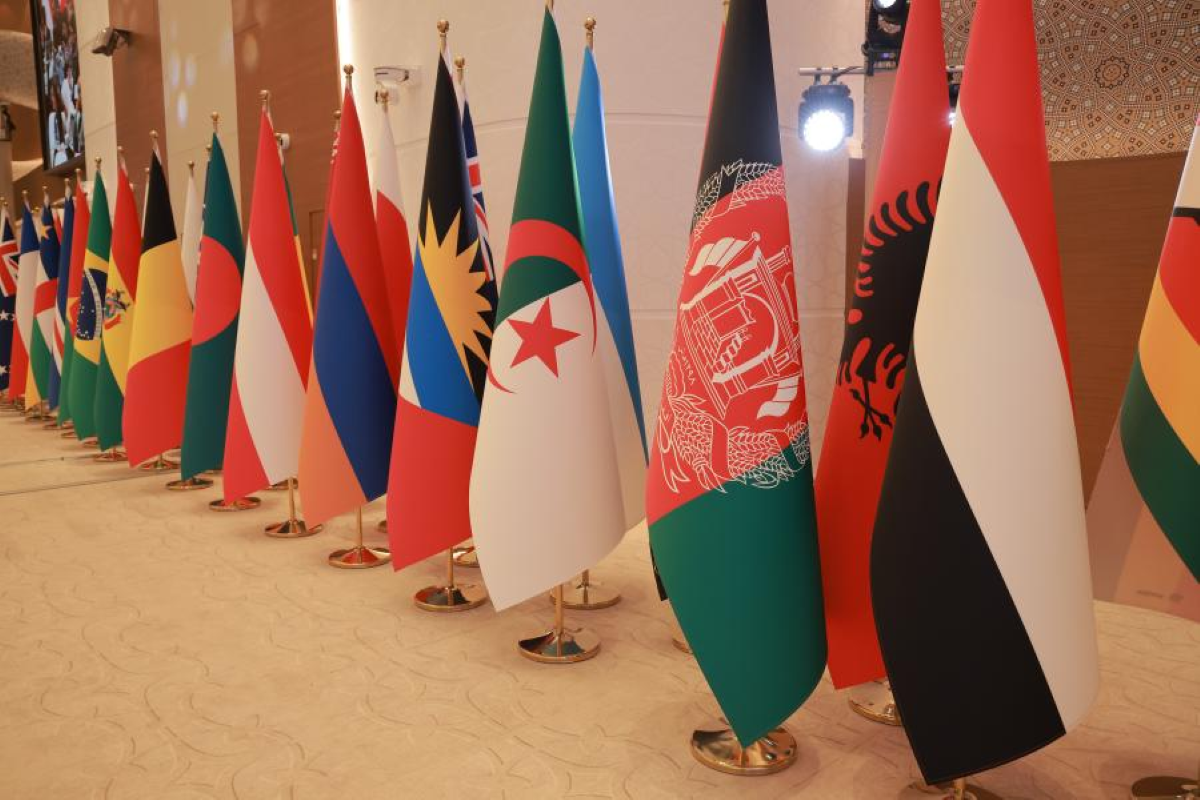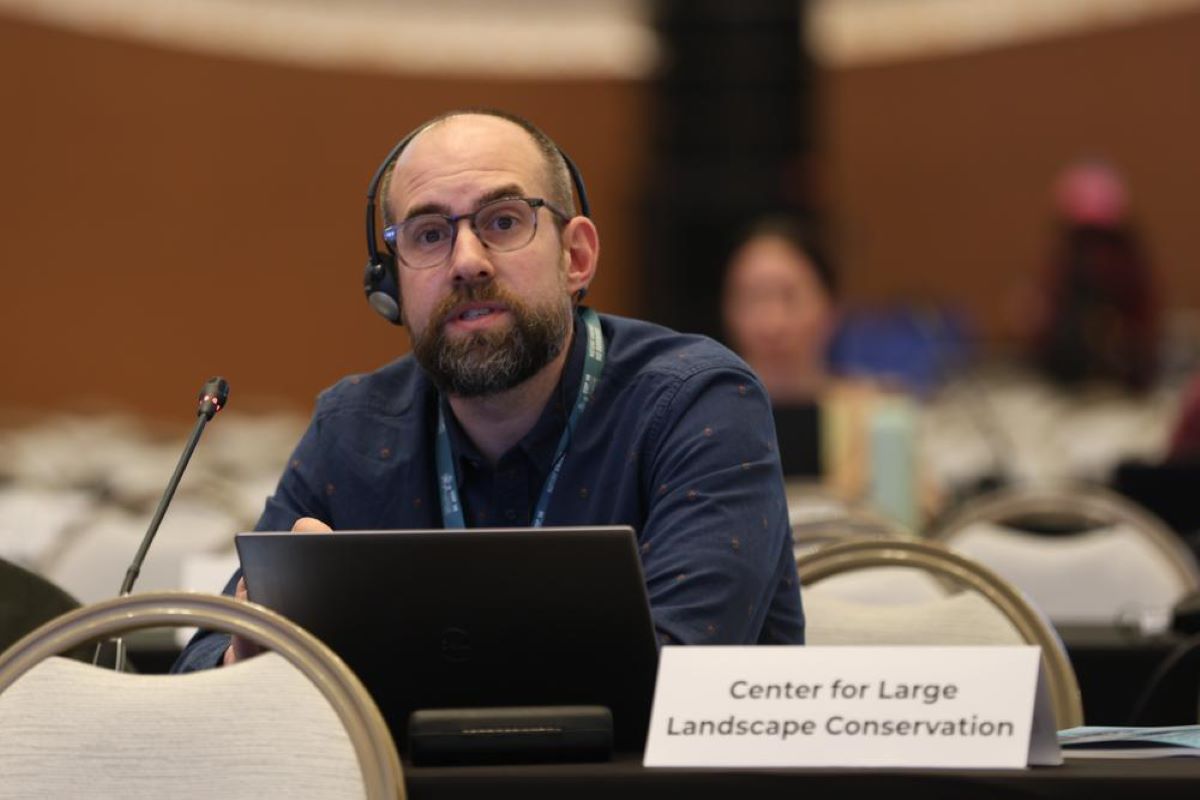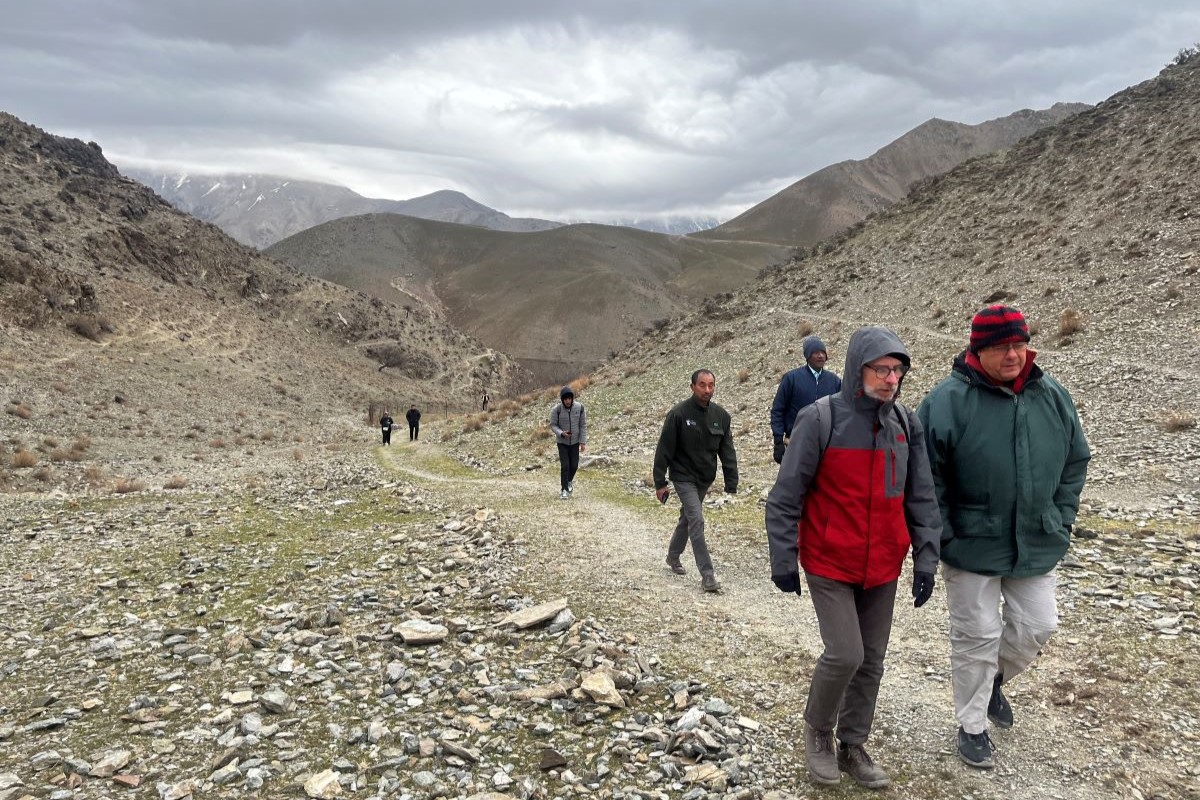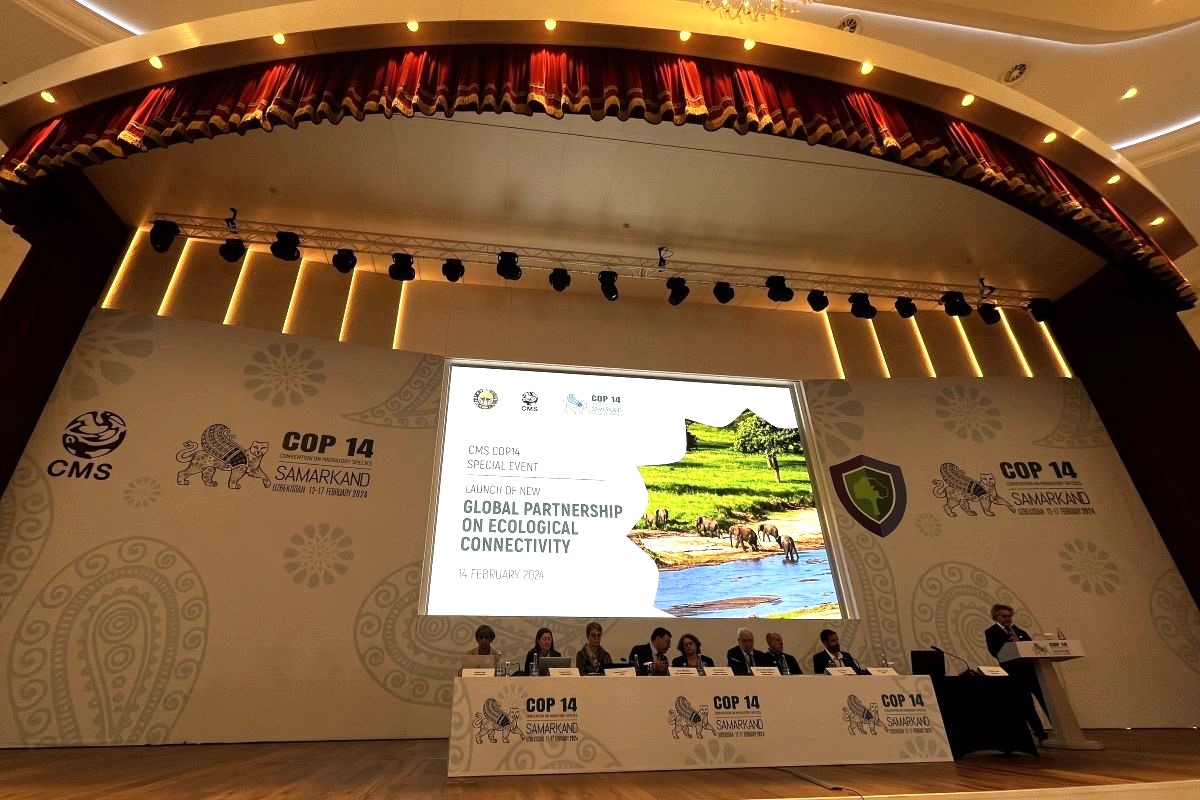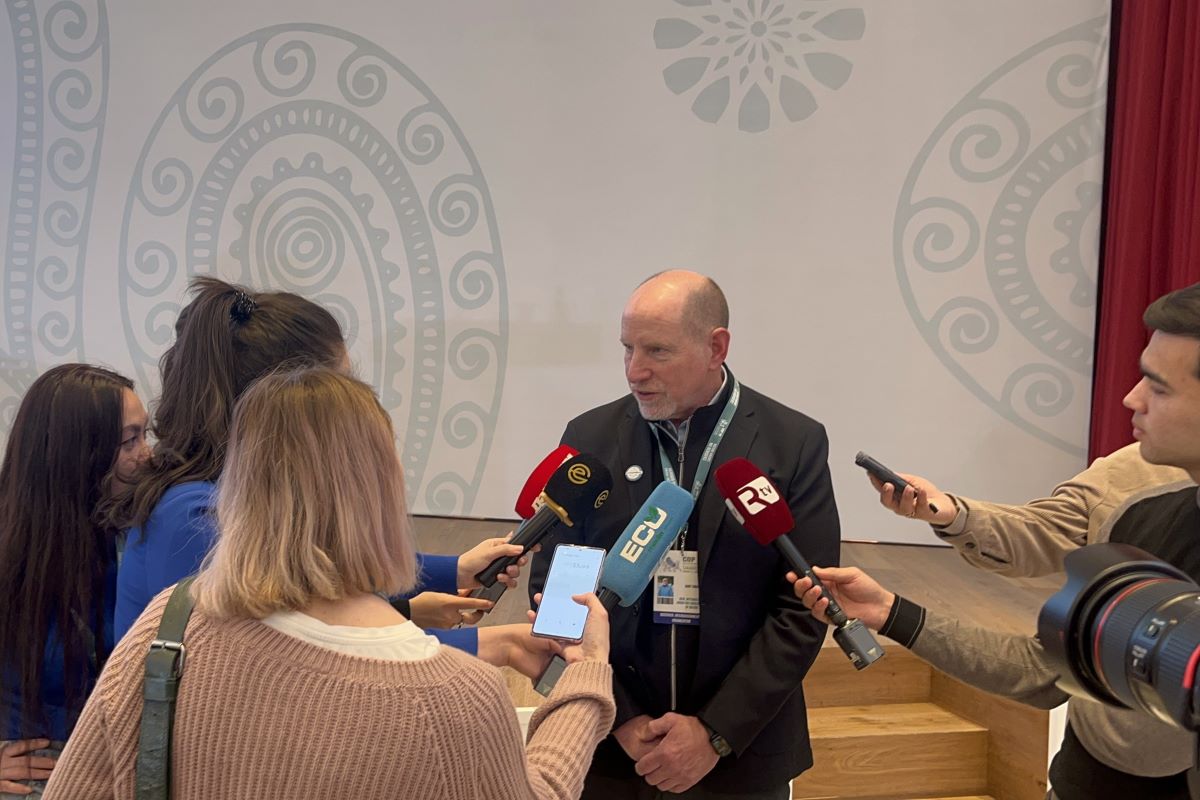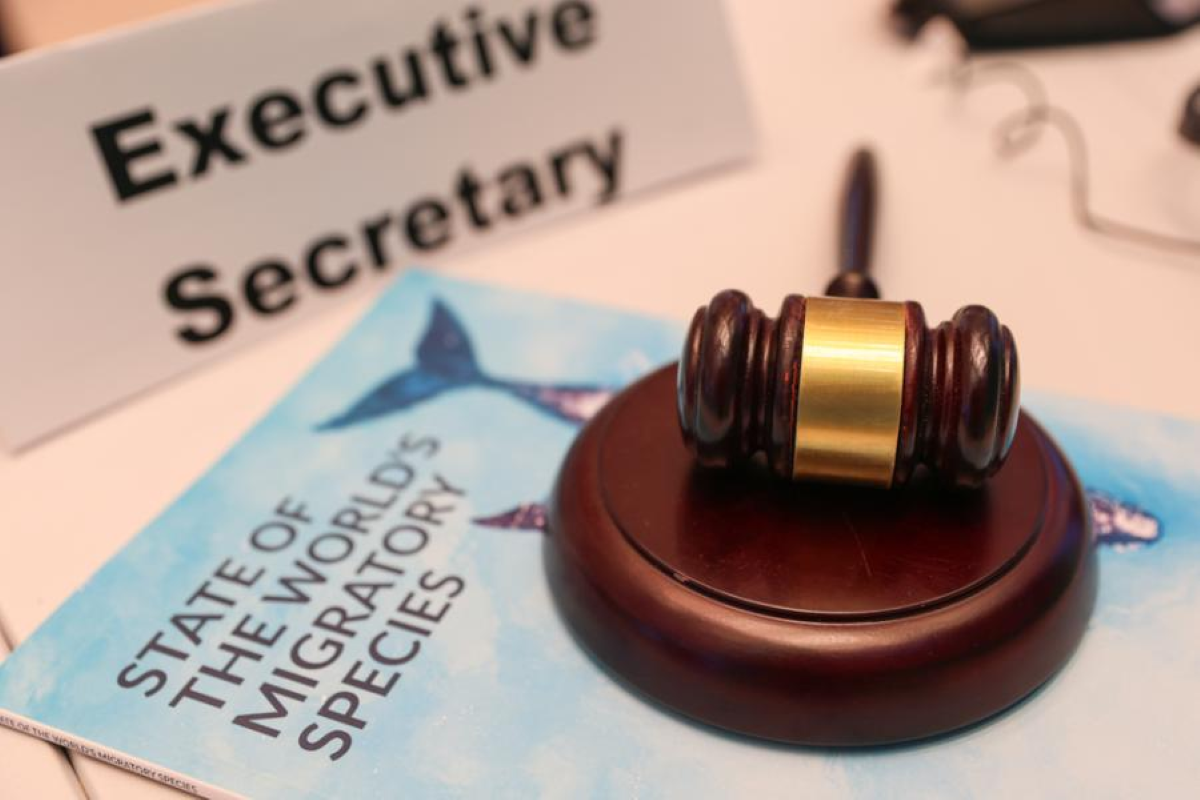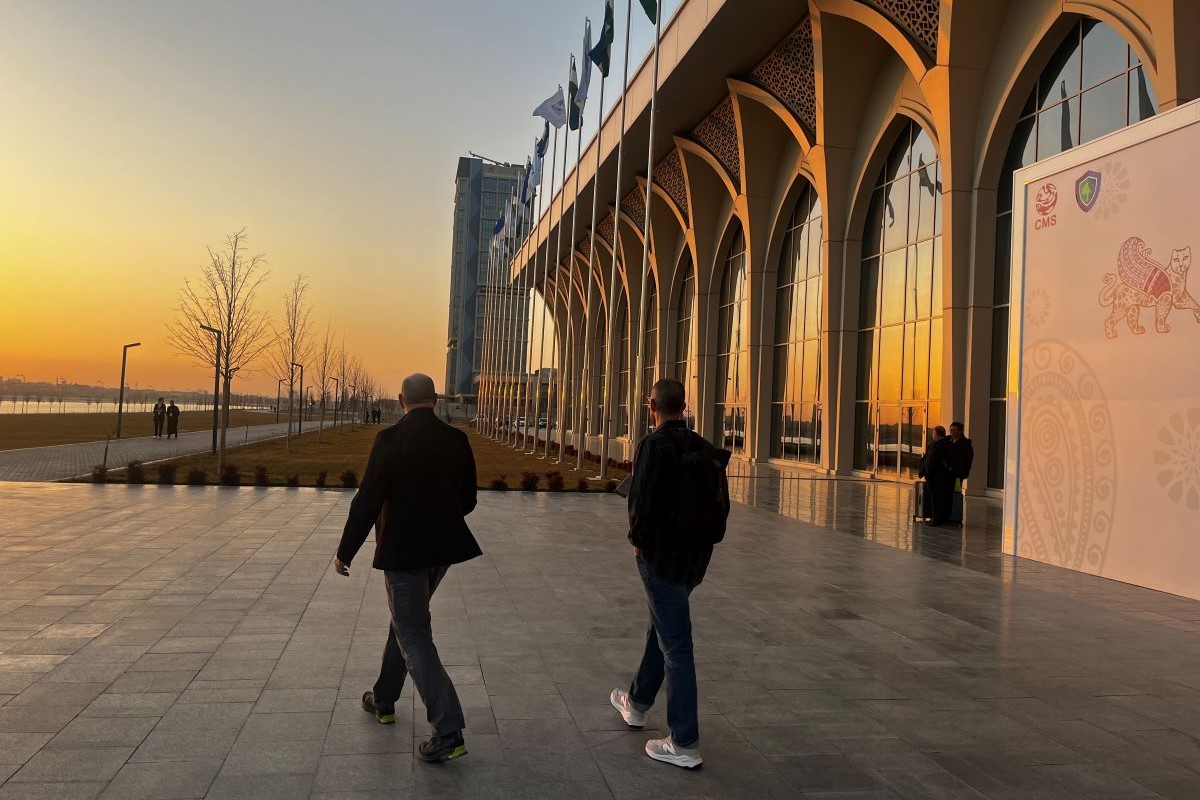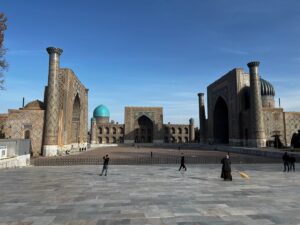
They run. They fly. They swim. Migratory species from elephants to golden eagles to sea turtles cover vast distances and often cross borders to survive. In February 2024, the Center for Large Landscape Conservation joined countries, partners, and experts in the ancient Silk Road city of Samarkand, Uzbekistan, to increase commitments and contributions to conserve migratory wildlife and their habitats around the world. Under the motto “Nature Knows No Borders,” more than 1,000 participants attended the 14th Conference of the Parties to the Convention on Migratory Species (CMS/CoP-14), the first to be hosted in a Central Asian country.
The conference centered around the 133 country “Parties” considering the endangered status and management of specific species—including fourteen new species, subspecies, and populations added to the Convention on Migratory Species (CMS) Appendices—examining country reporting, setting priorities such as targeted conservation plans, and agreeing on a budget for implementing overall aims of the convention. CMS/CoP-14 built on momentum since adoption of the Kunming-Montreal Global Biodiversity Framework (GBF) in 2022 and brought additional focus to the vital role that ecological connectivity—which allows wildlife to move more freely—plays in conserving species and habitats across migratory ranges.
Keeping connectivity a priority
The Center was proud to prepare and attend as an official NGO Observer to CMS, and to elevate its work in collaboration with the IUCN-WCPA Connectivity Conservation Specialist Group (CCSG) and partners promoting and mainstreaming ecological connectivity as a central focus of the convention and its activities. Among the 52 agenda items considered under 25 thematic groups on crosscutting, terrestrial, avian, and aquatic issues, the conference adopted the Samarkand Strategic Plan for 2024-2032 with Goal 2 devoted to maintaining and restoring connectivity. This post summarizes the related activities and outcomes that our leadership and collaboration supported while in Samarkand.
Launch of the State of the World’s Migratory Species Report
During a special event on February 12, the first-ever report on the State of the World’s Migratory Species was released by the Convention on Migratory Species. Available in English, French, and Spanish, the 88-page report reviews the status of migratory species and impacts of various threats to their survival. It includes a section on “Promoting ecological connectivity by removing barriers to migration” as a joint contribution of the UNEP World Conservation Monitoring Center (UNEP-WCMC) and the Center for Large Landscape Conservation.
Among the findings, the report details that:
More than one-in-five (22%) CMS-listed species are threatened with extinction.
Nearly all (97%) of CMS-listed fish are threatened with extinction.
The two greatest threats to both CMS-listed and all migratory species are overexploitation and habitat loss due to human activity.
Connectivity-related side events
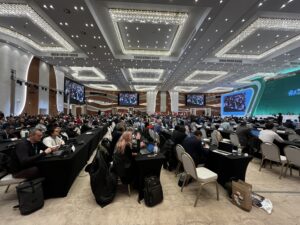
While formal negotiations feature prominently in daily proceedings of a CoP, side events are opportunities for gathering informally to learn about and discuss specific topics and projects. Prior to departing for Samarkand, the Center and partners identified 27 side events addressing ecological connectivity in one way or another.
Foremost, the Center led organization of the side event “New Frontiers for Ecological Connectivity – From Policy to Implementation,” where speakers highlighted efforts around the world moving ecological connectivity from discourse to implementation. Contributions included an overview of policy developments and presentations from governments and experts highlighting collaborative initiatives, projects, and activities that are advancing connectivity conservation at local to global scales. The event was supported by USAID and the ALIGN Project (Asia’s Linear Infrastructure safeGuarding Nature), and co-organizers included CCSG, CMS, World Wide Fund for Nature (WWF), Climate Chance, and the China Biodiversity Conservation and Green Development Foundation (CBCGDF).
Additional contributions by team members from the Center included:
- CEO Gary Tabor presented at the event led by Climate Chance association titled “Ecological Connectivity: An Integrated Opportunity to Address Climate Change, Biodiversity Loss, and Desertification”;
- CEO Gary Tabor also spoke at the event “Asiatic Wild Ass (Kulan): Status, Threats, and Future Conservation Needs” hosted by the IUCN-SSC Equid Specialist Group, co-chaired by Dr. Patricia Moehlman;
- International Connectivity Program Manager Aaron Laur provided a presentation on “Building the Foundation of Policy and Law for Ecological Connectivity” for an event led by the organization Law of the Wild; and
- International Connectivity Specialist Gabriel Oppler presented on the work of the Connectivity Conservation Specialist Group and its publications, resources, and activities.
Special Event: Launch of a new Global Partnership on Ecological Connectivity
The Global Partnership on Ecological Connectivity (GPEC) celebrated its launch at a special event on February 14. GPEC aims to strengthen and facilitate efforts to address key priorities for ecological connectivity, identify and address gaps, scale-up efforts at national-levels, and drive transboundary and international connectivity conservation policies and activities. The launch was attended by approximately 100 people and members of the media, and is summarized in this press release. Initiated by CMS, the partnership is joined by several organizations, including the Center for Large Landscape Conservation as a core partner.

Policy resolutions and decisions to advance ecological connectivity conservation
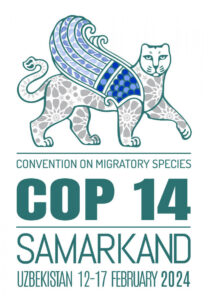
Among the many official decisions reached by close of CoP-14, Parties to the convention adopted policies that serve to update and focus efforts for more efficient and effective ecological connectivity conservation. Included among the “In-Session Documents” in English, French, and Spanish, they include:
- ECOLOGICAL CONNECTIVITY, including enhancement of the definition to “[…] ecological connectivity (hereafter “connectivity”) is the unimpeded movement of species, connection of habitats without hindrance and the flow of natural processes that sustain life on Earth”;
- IMPACT ASSESSMENT AND MIGRATORY SPECIES, including passages such as asking Parties to include migratory species when revising legal requirements for impact assessment and when generating considerations for screening criteria, including the construction of barriers such as fences and walls when these might be an impediment for ecological connectivity;
- INFRASTRUCTURE DEVELOPMENT AND MIGRATORY SPECIES with passages directed to Parties, the Scientific Council, and the Secretariat including requesting more comprehensive cooperation on specific actions such as identifying existing, planned, and foreseen development; and taking into account ecological connectivity and ecological restoration.”
- CMS CONTRIBUTION TO THE KUNMING-MONTREAL GLOBAL BIODIVERSITY FRAMEWORK, including supporting and applying the monitoring framework agreed under the CBD for the Kunming-Montreal Global Biodiversity Framework including promoting the status of migratory species as measurement of progress towards achieving the ecological connectivity and integrity elements of the framework;
- SAMARKAND STRATEGIC PLAN FOR MIGRATORY SPECIES 2024-2032, including Goal 2 on “The habitats and ranges of migratory species are maintained and restored, supporting their connectivity”; and Target 3.2. “By 2032, the direct mortality of migratory species caused by human-made infrastructure is significantly reduced to levels that are not harmful to species’ viability.”
- INITIATIVE FOR CENTRAL ASIAN FLYWAY spanning 30 Range States for migratory birds, alongside the establishment of a coordinating unit with financial support from the Indian Government;
- REDUCING THE RISK OF VESSEL STRIKES FOR MARINE MEGAFAUNA including encouraging Parties “to propose core aggregation zones and known migration corridors of vulnerable marine megafauna, where there is a significant risk of vessel strikes,” and
- INITIATIVE FOR THE JAGUAR to develop a comprehensive program of work encompassing all aspects of jaguar conservation, including paragraph 6(e) agreeing to focus on adopting actions that allow and ensure connectivity between Jaguar populations (including the creation and official designation of biological corridors), as well as effective handling of protected areas, indigenous territories, and other effective area-based conservation action;
What comes next?
Although many species-specific and cross-cutting decisions were reached throughout the week, extinction risk levels are rising across CMS-listed species, and climate change and habitat loss continue unabated. These challenges combine with chronic underfunding of the convention and a new budget that does not allow for even modest growth. The implementation of ongoing and new mandates will require strong, combined efforts across governments, organizations, and experts. The Center and our partners look forward to advancing ecological connectivity conservation as an innovative way for CMS and many multilateral environmental agreements to achieve their individual and joint objectives in a more comprehensive, efficient, and effective manner to stop fragmentation, reverse biodiversity loss, and increase resilience to climate change.
View some photos from our time in Uzbekistan
Top Photo: The CLLC team at CMS/CoP-14: Gabriel Oppler, Gary Tabor, and Aaron Laur (Credit: CLLC)
*Global Partnership group photo, left to right: Gabriel Oppler, International Policy & Partnerships Specialist, Center for Large Landscape Conservation; Aaron Laur, International Connectivity Program, Policy & Partnerships Manager, Center for Large Landscape Conservation; Frances Davis, Senior Programme Officer, UNEP-WCMC; Ingrid Coetzee; Director, Biodiversity, Nature & Health, ICLEI Africa and Global Cities Biodiversity Center; Senator Ronan Dantec, President, Climate Chance Association; Rafael Antelo (Ph.D.) Wildlife Connect Leader and PACHA Coordinator, WWF; Madhu Rao, Chair, IUCN World Commission on Protected Areas; Dr Musonda Mumba , Secretary General of the Convention on Wetlands; H.E. Aziz Abdukhakimov, Minister of Ecology, Environmental Protection and Climate Change of Uzbekistan; Amy Fraenkel, CMS Executive Secretary; Gary Tabor, CEO, Center for Large Landscape Conservation; Fernando Spina, CMS COP-appointed Councilor for Ecological Connectivity, Katharine Newman, Vice-President sustainable infrastructure; WWF US. © Anvar Zokirov
